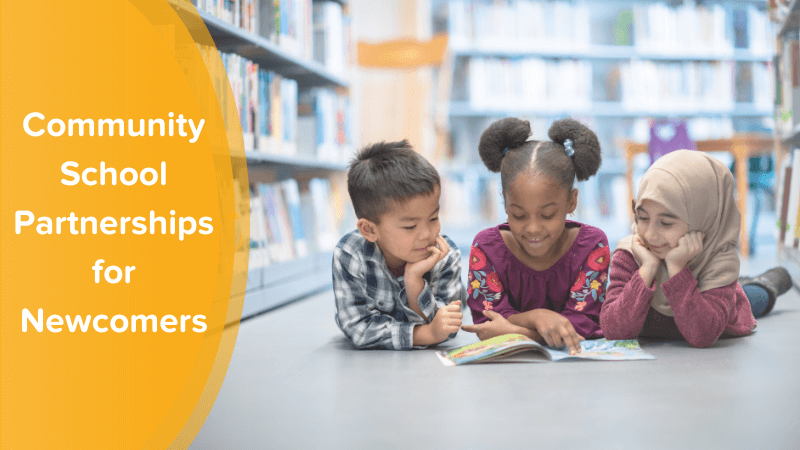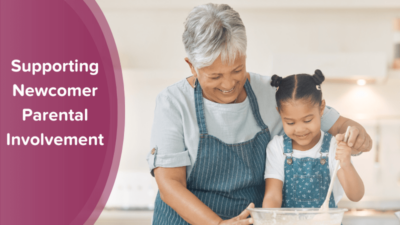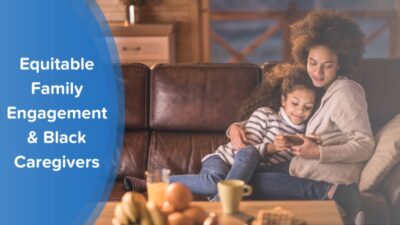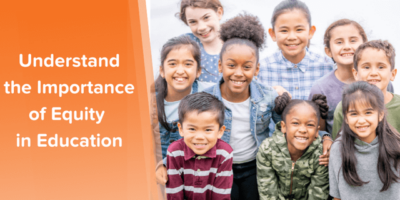By Maren Madalyn. contributing writer
As the old adage goes, “It takes a village to raise a child.” And most educators would agree that there are many individuals around each student who greatly influence their learning journey, from birth to high school graduation and beyond.
But what happens when entire schools take this proverb to heart? How do community school partnerships expand this “village” of support, going beyond what individuals can achieve and tapping into the power of the collective efforts to improve learning outcomes?
In this article, we explore the research behind family-school-community partnerships and various models for implementing collaborations with local organizations. More importantly, we unpack why these connections are powerful catalysts for whole-family and whole-child success — not only for those with particular needs (such as newcomers or those impacted by trauma) but for the entire school community.
Why are community school partnerships so critical for student success?
No student learns in a vacuum. All around them are countless factors that have the potential to help or hinder their growth and future success. These factors include family, friends, culture, the school climate, and even the surrounding neighborhood.
In fact, a school and its broader community can come together in a number of ways to uplift students and their families. The closest collaboration often involves bringing additional resources and services from community-based partners to school campuses, enabling families and students to get help with everything from dental health to wellness to financial literacy.
This framework is the foundation behind community schools, a model of learning to foster direct partnerships between schools and local agencies.
However, some schools may not have capacity or funding for this level of community involvement. That’s OK! Educators can still help with connecting families to community resources by spreading awareness of and information about services that families may need.

For instance, a school may create a family resource wall in the front office, so families can easily grab pamphlets for local mental health counseling services, free job-search workshops at the public library, and so on. Other districts may bring resources to families through tools like the Community Support Stream offered by ParentPowered. This technology allows educators to send curated notifications about community-based partners to families via text message.
The many benefits of partnering with community organizations
However communities and schools collaborate, effective partnerships bring many benefits to students and families. Below are just a few outcomes for children that community school partnerships cultivate:
- Reduced student dropout rates in high school
- Increased school attendance rates (and reduced chronic absenteeism)
- Boosts to social-emotional learning implementations within a school, which can help address specific student needs as well as foster positive school climate
For newcomer families — who may have specialized needs as they adapt to a new country, language, and educational norms — community involvement is especially important. Some local agencies may focus on assisting immigrant families with employment and housing. Others support refugee families with mitigating the impact of trauma on their daily lives.
Caregiver and parent engagement goes hand-in-hand with school-community engagement. By collaborating with trusted community leaders and partners, educators build a bridge to establish trust and connection with their families. In turn, as families feel more supported by their schools, they take steps to engage in their children’s learning experiences. Schools then learn from families’ experiences and shared knowledge of students to guide students’ academic success — and onward the cycle continues.
Want more inspiration about the power of community support for newcomers? Read the story of the Montana OPI Migrant Education Program and how they provided critical resources to uplift migrant families and their students, or watch our on-demand webinar to discover best practices for engaging newcomers.
Community schools: A framework for strong school-community partnerships
One of the most robust examples of collaboration between schools and community-based partners is. . . the community school! But what exactly are community schools, and how do they differ from more “traditional” learning programs?
The National Education Association defines community schools as “public schools that provide services and support that fit each neighborhood’s needs, created and run by the people who know our children best—all working together.”
Many states across the U.S. are exploring the community school model as a way to address students’ fundamental needs academically, socially, emotionally, and mentally. Funding challenges often affect what resources school staff can provide on their own, so teams may turn to local organizations for additional support:
The Brookings Institute outlines six elements which underpin effective partnerships between community schools and local agencies. In synchrony, these elements improve student wellbeing and academic outcomes:
- Empower family and student engagement
- Invest in collaborative leadership, shared power, and voice
- Expand and enrich learning opportunities for students
- Integrate multiple systems of support
- Instruction is rigorous and community-centered
- Cultivate a culture of safety and belonging
It’s easy to see how these factors benefit all families — but they are particularly helpful for newcomers. When educators foster positive relationships with families new to the U.S., leaning on the help of community-based partners, they are giving families a safe place and space to deepen family involvement in learning.
Resources About Community Schools
- Read the Community Schools Playbook compiled by the Partnership for Future of Learning for best practices and insights into successful community schools.
- Explore these articles from the Brookings Institute all focused on the latest news and impact of community schools.
Powerful examples of community school partnerships from the field
The good news is that educators like you across the country are leveraging best practices from community schools to uplift newcomer families! In the spirit of shared success, we curated real stories from the field of effective collaborations among families, schools, and community leaders.
Oakland, CA: Bridging cultural divides through sports
In the East Bay Area of Northern California, one school invests in a culturally responsive approach to their diverse student population.
At Oakland International High School (OIHS), many students are recent migrants to the U.S., arriving from as far as Yemen and as close as Mexico. To support their diverse student population, OIHS collaborates with multiple local agencies and nonprofits to break down cultural barriers and create a cohesive learning community.
The school takes a community-connected approach to instruction, too — meaning teachers celebrate the strengths each student brings to school. They achieve this by intentionally connecting learning and school activities with the wide range of communities and cultures found in each classroom.
For example, students may take a community walk, leading their peers and teachers through their neighborhood to explore a local halal market or sample foods from their home country. Or, a group of students with a shared heritage may present their home country’s history, customs, and traditions to their peers.
Such a culturally rich population of students, however, also brings challenges as students navigate tensions and divides that may stem from their international backgrounds. But OIHS found one common ground: Many of these students shared a deep love of soccer.
Recognizing an opportunity to bridge gaps, OIHS partnered with the nonprofit Soccer Without Borders (SWB) to launch an after-school program. Today, more than 40% of OIHS students participate, building stronger relationships with peers and, with the help of SWB coaches, practicing conflict resolution skills through the sport.
By adopting a strengths-based approach to curriculum and collaborating strategically with local organizations, OIHS is building a positive school culture that honors newcomer families’ experiences and paves a path forward for every student to succeed. Learn more about this school’s approach to community school partnerships and its impact on migrant parent engagement.
New York City, NY: Driving positive outcomes through community partners
Since 2014, the New York City Department of Education (NYC DOE) has steadily invested in their Community Schools Initiative (CSI), growing the number of such buildings from 45 to over 400 to date.
Overseeing these efforts is the Office of Community Schools, whose mission is to “create and sustain school and community-based organization (CBO) partnerships through intentional collaborative leadership that empower students, families, and communities to thrive.” And there is much progress that NYC DOE and its districts have achieved towards this vision of family-school-community partnerships.
Below are just a few of the positive outcomes for children that RAND researchers uncovered while studying the CSI between 2018-2020:
- Overall, community schools across NYC had a positive impact on student attendance for students in all grades and across all three years of the study. Data analyzed by the NYC DOE confirms this finding, as NYC community schools decreased chronic absenteeism rates between 2014-2019 by 9.6% — nearly 20 times the citywide decrease of 0.5% in that same period.
- Further, high school students’ graduation rates increased at most community schools during two of the three years of this study. Relatedly, high school credit accumulation also increased for students across all three years.
- Some academic improvements were also found, especially on math achievement during the third year of the study.
- Students were not the only ones to benefit from the community school models. Teaching staff reported an increased sense of shared responsibility for student growth at both elementary and middle schools in the second and third years of the study.
In such a diverse city, community-based partnerships are proving effective for newcomer family involvement, too.
For instance, the Children’s Aid Society has collaborated with NYC community schools for nearly a decade, bringing vital services to families such as advocacy events, literacy and English classes, and other learning programs to further their career development.
Other districts like Community School District #17 are leveraging modern technology to bring specialty supports directly to families across their 32 school sites, thanks to ParentPowered Trauma-Informed.
Additional examples from Chicago, Cincinnati, and Orlando
Though the stories below are not centered solely on newcomer families, they demonstrate the power of strong community-school collaborations to uplift students and the adults who support them.
Chicago, IL
In Chicago Public Schools (CPS), there are 213 community schools scattered throughout the city. Most building teams select a lead community partner agency to hire a resource coordinator and manage the services and activities provided to families. This coordinator also recruits additional partners to expand on or deepen resources for families in high-priority areas of need.
But these partnerships alone cannot drive comprehensive gains in student learning and wellbeing. This is why CPS partnered with the American Institutes for Research (AIR) to implement and study school-based structures that support shared decision-making among school principals, school staff, and families.
Learn more about the best practices in family leadership that AIR and CPS co-created, and which strategies were effective in uplifting caregivers’ voices.
Cincinnati, OH
Prior to investing in an Ohio-specific model of community school partnership, Cincinnati Public Schools was facing declines in enrollment, decreases in student and staff engagement, and budget challenges. After supporting 65 schools to become community learning centers, the district has witnessed remarkable transformations, including:
- Gains in student engagement as schools adopted project-based learning strategies in their curricula
- Increased graduation rates of as high as 7 percentage points
- Narrowed achievement gaps between Black and white students by as much as 10 percentage points
The district credits schools’ concentrated efforts to promote community-wide safety and student ownership over their learning as core drivers behind these outcomes. Read the story to discover how school staff at select sites created unique support systems for their families’ specific needs.
Orlando, FL
In 2013, on the east coast of central Florida, Evans High School (EHS) made a radical shift to become a community partnership school to improve their sinking graduation rates. The leadership team established relationships with three community-based organizations with Orange County Public Schools, each bringing critical services directly to their families that tackled barriers to life success like food insecurity and healthcare.
Jarvis Wheeler, a former EHS teacher and director of 27 community schools in OPS, shared his reflections on the programmatic shifts during a 2023 interview:
When you think about Maslow’s hierarchy of needs, it’s hard for a student to focus on class when they’re hungry or if they can’t see the board. But. . . you get a student glasses and they can see. All of a sudden now, a student has a mental health counselor when they’re struggling and they get the support that they need. As opposed to getting a discipline referral, now they’re staying in school, now they’re performing well.”
Jarvis Wheeler, Former Evans High School Educator
Services provided through community school partnerships at EHS range from summer learning and tutoring supports to medical services to specific parent resource events. Discover the impact of EHS’ community collaborations on student attendance, achievement, graduation, and more.
Cultivate strong partnerships through ParentPowered
Community school partnerships are clearly effective in cultivating positive school environments, student achievement, and a cohesive learning community. And ParentPowered’s family engagement programs are the perfect complement to these collaborations.
Our evidence-based tips and activities are designed to reach families where they are, celebrate who they are, and encourage them to apply all the strengths they have to offer towards their child’s success. By scaffolding families for successful partnership with school staff and offering easy opportunities for engagement in learning, ParentPowered sets the stage for everyone to thrive.
Join an upcoming info session or watch a self-paced tour to learn how our Trauma-Informed program can catalyze the impact of family, community, and school partnerships!
About the author
Maren Madalyn has worked at the intersection of K12 education and technology for over a decade, serving in roles ranging from counseling to customer success to product management. She blends this expertise with fluid writing and strategic problem-solving to help education organizations create thoughtful long-form content that empowers educators.











